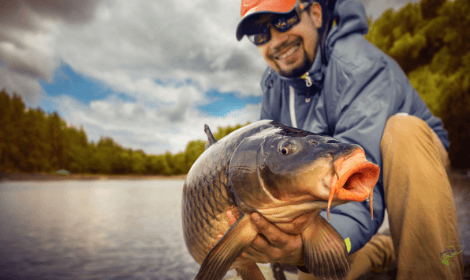
Carp fishing has grown as a massively popular sport across the world especially in the UK and some parts of Europe where carp are seen as high class sport fish.
Carp grow to ridiculous sizes and their powerful tails and heavy bodies make for a great fight so its no surprise this sport has become so popular.
In the UK literally millions of anglers target carp and other coarse fish with this number growing significantly every year as we progress into a new decade.
This post is going to be focused towards the new and aspiring carp anglers asking “What is carp fishing?”.
Some background information in this post is going to be focused on the carp species commonly found across the UK but methods and tackle for targeting these carp are universal across the world.
In this post I’m going to be providing information on;
- What is Carp Fishing
- History of Carp Fishing
- Common types of carp
- Basic Carp Tackle
- Basic Carp Rigs
- Carp Baits
- How to cast accurately
- Carp safety
What is Carp Fishing?
Carp fishing, in the most basic terms possible, is going out to catch the carp species using a rod, reel and various other fishing tackle.
Carp fishing has its own specific fishing methods that are rarely used for other type of fishing. As this fish has particulate feeding habits and is known for being hard to catch new fishing methods have been developed over the year by experienced carp anglers.
Nowadays carp fishing is huge across the UK and Europe with millions of anglers devoting time to fishing for the species of carp.
To build a picture of exactly what carp fishing is this post will provide you with an overview of the sport and how you can begin to target these elusive fish.
History of Carp Fishing
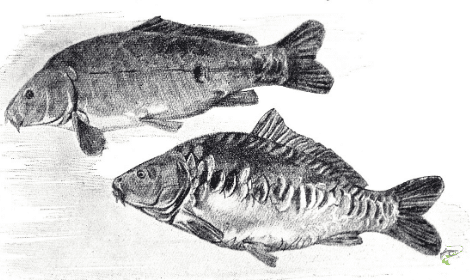
Carp are fish from the large “Cyprindae” family that are native to Europe and Asia. Nowadays though carp can be found across nearly every continent on the planet.
It is thought that carp were first introduced into the UK by the 15th century by monks. These monks domesticated the wild fish from mainland Europe and kept them in ponds on abbey grounds to provide food.
Access to the fish in these abbey ponds was very closely controlled so the soft white meat of these fish was not available to the masses. Back in these times, carp meat would have been seen as an extremely high value food.
Selective breeding allowed for these relatively small wild fish to begin growing to then unprecedented sizes which began the transition into the breeding of the massive fish we have swimming in our waters today.
Over these initial years of carp in the UK escapees and transfers into rivers and lake began the spread of carp in UK waters. Due to carp yielding hundreds of thousands of eggs per spawn the more “wild” population began to grow rapidly.
As carp are bottom feeders and feed on vegetation it is thought that some native species such as Rudd and Tench may have been saved by these fish. The hundreds of thousand of eggs expelled into the waters during the carp spawn also provide a food source for native fish.
This marked the beginning of the carp population in the UK but the real angling side started in the 18th century when new variations of these fish were imported from Europe. This started with the importation of the mirror carp from Holland and Germany.
Thomas Ford who owned “Manor Fisheries” was the first man to kick start the carp angling in the UK.
These imported fish were stocked in his pond and were often over 10lbs which dwarfed the native fish such as the perch and roach that anglers were used to catching.
Due to their sheer size and their reputation for being hard to catch the carp fishing craze started and anglers came from far and wide to try to catch some of these fish.
Donald Leany was the next big name to start importing carp into the UK. He imported hundreds of thousands of these fish which were used to stock some of the most famous fisheries in the UK today.
The selective breeding from breeders across Europe and also in the UK is why carp are massively different in sizes and shapes today.
Originally fish from Holland had the ability to grow to unimaginable sizes through sustained bone growth for longer than usual.
On the other hand, fish imported from Italy would reach impressive weights but would not grow as long as the Dutch fish. This meant that these large fish were nearly as deep as they were long.
As the carp angling buzz spread across the UK and fisheries within the country started to breed these fish actively fisheries began to open up across the country.
Common types of carp
Now that you known where the carp in the country originally came from and how the carp fishing craze began, we can take a look at the types of carp that you can find in commercial fisheries today.
I have already written a full length post on the types of carp in the UK so I will keep this section as brief as possible to give you beginners to carp fishing a quick introduction.
You can read the full post on types of carp here.
Common Carp

The common carp or “Cyprinus carpio” is one of the main types of carp you will catch across the UK and Europe.
This fish is native to Asia and Europe but has now been introduced into nearly everywhere in the world and was even farmed for food as far back as the Roman times.
As this fish is classed as the “common carp” you would expect your chances to catch this fish would outweigh the others but in UK fisheries this is quite often not the case.
It is not unheard-of for fisheries to stock large quantities of mirror carp and other species so depending on the venue you might find a large common a little hard to come by.
Even to this day in the Czech Republic, Poland and Slovakia this fish is still consumed as part of Christmas dinner.
Although there is an abundance of these fish across the world “native” common carp are currently classed as vulnerable to extinction by the International Union for Conservation of Nature.
This is to do with the majority of fish being classed as “domesticated” as they have been bred for angling purposes or to be introduced to control aquatic plants and pest organisms.
Mirror Carp

Mirror carp are a sub-species of the common carp and was the first mutation. These fish are almost biologically identical to the common carp apart from its distinctive scales.
Mirror carp lack scales which are commonly thought to have been bred out by monks to make the fish easier to consume as fewer scales had to be removed.
Today these mirror carp are mainly bred for carp fishing purposes to be introduced into commercial fisheries.
Just like the common carp these fish put up a top class fight and grow to massive sizes. The world record currently stands at 108lbs which is far bigger than the world record common of 64 lbs.
As you can see mirror carp seem to grow a lot bigger than commons and this is due to the energy it takes to grow scales. Commons put a lot of energy into growing scales covering their full body but mirrors put this extra energy into growing their full body.
Leather Carp

This is another subspecies of the common carp which is quite often thought to be a mirror carp with no scales whatsoever. This is not the case as leather carp have some genetic differences.
These fish have fewer red blood cells than mirrors and commons which stunts their growth and means they never really reach the ridiculous sizes of mirror carp.
Leather carp are very range in angling purposes and the information available on them is rather scarce.
Cruician Carp

The Crucian is the smallest carp in the family and rarely grows over 6 lbs.
They are commonly found across Europe and are even found as far north as the Arctic Circle in Scandinavian countries.
They can survive in very harsh conditions including, small weedy ponds, muddy waters and also extremely cold temperatures.
Due to their small size even a 2lb crucian carp is classed as a great catch.
These fish are extremely delicate feeders and instead of gulping in baits these fish will nudge the bait first to inspect for any hooks or suspicious movement.
This makes these fish extremely hard to catch and can be very frustrating for carp fishermen going after these fish.
Koi Carp

The Koi carp was originally bred in Japan in the town of Ojiya for their bright colours.
The word “Koi” comes from Japan and simply translates to “carp”. The Koi carp was kept isolated in Japan until around 1914 where it was displayed at a public exhibition in Tokyo.
After this the hobby of keeping Koi as ornamental fish grew rapidly and many new variations were bred.
There is now thought to be more than 22 varieties with each colour having distinct colours, patterns and scaling.
Fishing for Koi carp is rare as these fish are extremely expensive but a few fisheries in the UK stock a few carp which can be extremely exciting to catch.
Grass Carp
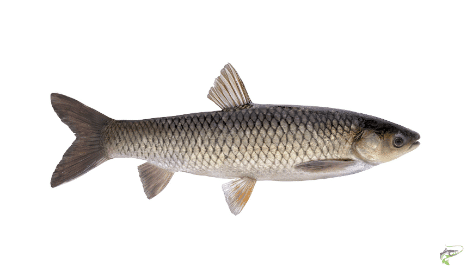
The grass carp is a carp species that is native to China and is not so commonly found in the UK and Europe for carp fishing.
This fish was introduced into a lot of countries worldwide to control aquatic weeds. They were first introduced into the Lancaster Conal by British Waterways and the University of Liverpool.
As grass carp need water temperatures of over 20 degrees C to reproduce they are unable to reproduce naturally in UK waters.
This allows for their population to be controlled closely by the Environmental Agency.
Grass carp grow rapidly due to them eating up to three times their body weight each day.
In the UK grass carp can be caught at selective fisheries including Badshot Lea, Mill lane, Little Moulsham Lake and of course the Lancaster Canal.
Basic Carp Tackle
Like all type of fishing you are going to need a rod that is suitable for the type of fish you are targeting. As there are many different approaches to targeting carp the rods and reels you choose can vary quite significantly.
For the purpose of this post I’ll try to keep the introduction as brief as possible and provide you with enough information for you to go conduct a bit more research before you decide on the rod and type of carp fishing you want to start with. You can have a read at this post on carp fishing rods if you are looking for some extra detail.
Rods
Most commonly there are three types of carp fishing rods you can choose depending on the type of fishing you plan to do. These are;
- Standard carp fishing rods
- Quiver tip rods
- Float fishing rods
Standard Carp Fishing Rods
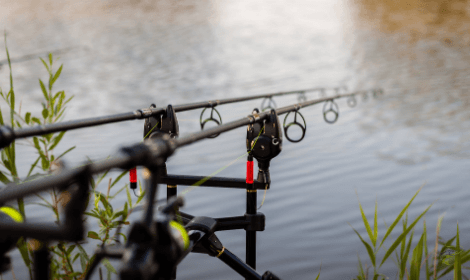
These rods come in varying lengths, action and test curves that will depend on how far you want to cast, what size of fish you are targeting and some personal preference as well.
Longer rods generally mean you will be able to cast further as more force is propelled through to your rig to send it long distances.
The action of the rod refers to how much of the rod bends under load.
Fast action rods only bend the last section of the rod and are excellent at casting long distances and allow you to retrieve fish quickly and keep control over hard fighting fish.
If you are a new angler the chances are you shouldn’t be looking for a fast action rod.
Middle to tip action rods, as the name suggests, bend from the middle of the rod to the tip. These are great for mid range fishing and are the most common rods for carp fishing.
These rods provide enough power for casting but are also rigid enough to control fish at close range but have enough bend to avoid too many hook pulls.
Through action rods bend all the way to the handle and are not very common at all. They are used for fishing close distances when casting light rigs.
They are great when fighting fish at close distances as every movement from the fish is felt in the rod handle but they might not be able to handle massive fish.
The main difference with standard carp fishing rods is that they don’t have any integrated method for indicating bites or fish on the line.
Due to this they need to be used with bite alarms that beep when you have a fish on or something is moving you line.
Quiver Tip Rods
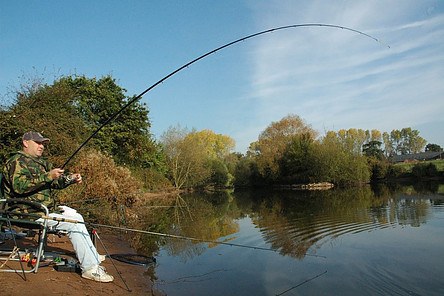
Quiver tip rods also come in various lengths, test curves and action with the main difference being the bite indication method. These rods have fine rod tips that bend and move every time your line is touched in the water.
When you’ve hooked into a decent fish the rod tip will bend significantly. This means you’ll need full concentration on this rod tips to ensure no fish are missed or your rod could even be pulled into the water.
These rods will usually come with around 3 tips of various test curves. This basically means how light and flexible they are.
An extremely flexible rod tip will give the best bite indication as it will bend at the slightest movement of your line.
The weather can affect what tip you chose on the day.
For example if it is windy you’ll want to opt for the stiffer rod tip to avoid the wind blowing your tip around or every gust of wind might be mistaken for a bite.
Feeder fishing with a quiver tip rod is personally my favourite way for carp fishing. If you are looking for a great feeder fishing rod for beginners take a look at these two reviews;
Float Rods
Once again float rods will come in various actions, test curves and lengths that will vary depending on the type of fishing you plan to do.
These rods are generally lighter than the previous two and are designed to be held for long periods of time. When float fishing your bite indicator is the float so no quiver tip or bite alarm is needed.
Float rods are usually smaller as you are not going to be casting far distances and will usually be fishing the close margins.
Reels
There are many types of reel you can opt for but in the beginning a simple bait runner reel will do the job.
A reel at around the £50 should be more than adequate for beginner carp fishing.
Reels also come in various sizes but a 4000 size reel should be perfect for your first carp fishing experiences.
You should look to put on between 6-8lb line on your reel and make sure its filled to the correct level.
The video below will show you how to get line onto your new reel.

Basic Carp Rigs
There is many different rigs you can use for targeting carp from, float fishing to quiver-tip fishing, but I’m going to show you how to use two of my favourites that should get you catching carp in no time at all.
These rigs are the;
- Method feeder Rig
- Chod Rig
Method Feeder Rig
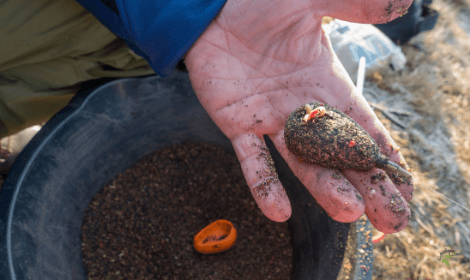
As we should all known, carp are primarily bottom feeders and swim around looking for food on the bottom of the lake.
The method feeder rig aims to target these fish feeding on the bottom. It does this by allowing you to mould a ball of groundbait or micro-pellets around a “feeder” that will sink to the bottom of the lake and attract in nearby fish.
These rigs will also have a hair rig attached that allow your hook bait to be presented as naturally as possible near this patch of free bait.
The method feeder rig will help to bring carp into the area you are fishing with the hope they will pick up your hook bait.
I have already written plenty of posts on method feeder fishing that will cover everything you need to know from setting up your method feeder rig to the technique of fishing the method feeder.
Be sure to take a read at these!
Chod Rig
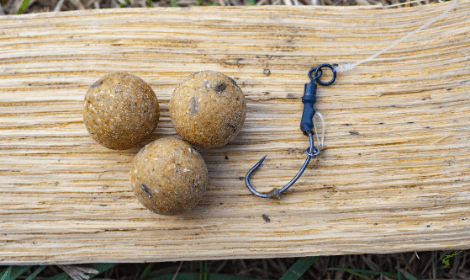
The Chod Rig is another basic rig that can get you catching carp in no time. This rig is also used for fishing near the bottom but allows you to present your bait above any weeds or debris on the bottom of lake.
This rig allows you to present your bait naturally nearly anywhere on the lake so you don’t have to worry about avoiding weeds or snags when you are new to carp fishing.
This rig also makes it difficult to lose fish once hooked so this is another reason why its great for beginner carp anglers.
If you are looking for information on how you can set up the rig, the types of chod rigs and the baits you use with the rig take a read at this post for all the information you’ll need;
Carp Baits
Choosing the right carp bait can also be a challenging task for any beginner. Tackle shops are literally filled with carp baits with different, types, flavours and sizes available.
So which ones should you choose?
The bottom line is you don’t need to look for anything too fancy in the beginning and you’ll find the basics work just fine if not better on most occasions.
The only baits you should need are;
Take a read at my post on the best baits for carp for all the reasoning behind why these baits are the best for carp fishing.
Casting Accurately
When fishing rigs such as the method feeder or even chod rigs how accurate your casting is can be the difference between plenty of fish or none at all.
When fishing the method feeder you want to be casting to areas that should hold fish such as near features.
Also, once you start to bait up a swim with a method feeder the carp should start to build up in this area eating all the free bait you are casting into the swim.
This means you’ll want to be casting your rig back to this spot every time to take advantage of the fish grouped up feeding on this spot.
Luckily there’s steps you can take to learn how to cast accurately that you can read all about in this post on how to cast a method feeder accurately.
The tips you will learn are as follows;
- Correct amount of line between rod tip and feeder
- Use both hands
- Stand straight
- Point the rod tip where you want to cast
- Release at right moment
- Acknowledge the wind
- Choose the right weight of feeder
- Select a good swim
- Use the line clip
- Use the right type of rod
Carp safety

It is an absolute certainty that beginner carp anglers learn how to handle carp when they are on the bank. There is a few simple steps you can take to keep the fish healthy when out of the water.
You should always have a large enough unhooking mat close to the bank with a bucket of water from the lake nearby. Every fish that is removed from the water with a landing net should be placed on a wet unhooking mat.
The matt needs to be wet to reduce the chances of rubbing any of the protective slim layer off the fish.
The fish should not be kept out of the water for long periods of time and should be returned to the water as quickly as possible.
Handling the fish for photos must also be done very carefully.
Take a read at my guide on how to handle carp to get a full step by step guide of how to keep the carp safe and healthy when handling.
That’s All!
If you have read this post in detail you should known exactly what carp fishing is and how you can get started catching these elusive fish.
This sport provides an exciting opportunity to get out into the fresh air and get the adrenaline flowing.
If you need any more advice or have anything to add to this post please leave a comment below and I will get back to you ASAP. Thanks for reading!

